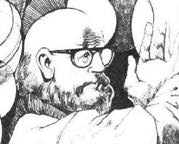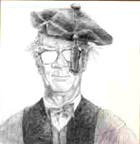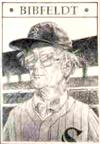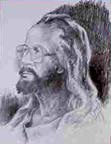

 The University of Chicago Magazine
Feb 1995
The University of Chicago Magazine
Feb 1995
By John Easton




Mood swings: The many faces of Franz, as seen by Siegfried Reinhardt (top left) and David Morgan, PhD'90, who drew the theologian receiving an honorary degree from Twaddle Community College, catching a Sox game, and suffering delusions of grandeur.
Has it never bothered you that the Romans counted backwards? No one should wonder about the collapse of an empire that numbered each succeeding year in reverse, with 751 B.C. following 752 following 753. What appears to have gone unappreciated for nearly 2,000 years, however, was the difficulty surrounding the transition from counting down to up.
No doubt there was an explosion of millennial groups throughout the descending-single-digit years(1): parading through the streets, posing for the media, bellowing vulgar slogans, and toting semi-literate placards. The consequent disruption, coupled with reliance on those elegant but unwieldy numerals, resulted in an apparently careless omission that, despite its casual occurrence, throws all of subsequent history-at least the 1492, 1776, 1812 sort of history-into question.
"Chronologers admit," says the Encyclopaedia Britannica, "no year between 1 B.C. and A.D. 1." By reckoning in this manner, notes the Encyclopaedia, "there is an interruption in the regular succession of the numbers." For chronologers, this merely fouled up the leap years. But Robin Lovin-a former U of C professor who is now dean of the Perkins School of Theology at Southern Methodist University-brings home the impact of this on the common 1-B.C.. man, who probably found himself uncommonly inebriated on the eve of such a noteworthy new year. "One minute you're a full year before Christ," notes Lovin, "and then, BOOM, one minute later, you're into the first year of the Christian era, with nothing in between."
While Britannica laments the "ambiguity" occasioned by this omission, even hard-core revisionist historians have been slow to recognize the significance of the error, or attempt to correct it. Why? Consider the ever-mounting magnitude of the task. Imagine, every check written since has been post-dated by one year. Or consider the plight of schoolchildren stumbling through the rhyme: In fourteen-hundred and ninety-one, Columbus sailed the ocean...the ocean what? The ocean fun? Most of his crew died. The ocean dun? Don't waste your time; it can't be fixed.
The only modern scholar to tackle this issue is the more-or-less University of Chicago-based German theologian Franz Bibfeldt, who in 1927 submitted his doctoral thesis to the University of Worms on "The Problem of the Year Zero." Like most truly innovative works, Bibfeldt's thesis was not initially well received. But Bibfeldt scholars do find in it early signs of the overarching theme that came to dominate all subsequent efforts of the man who is perhaps the most adaptable intellectual of our century: the search for the missing middle.
"His dissertation," notes Sam Portaro, Episcopal chaplain at the University's Brent House, "took him quite literally into the temporal via media and thus established his lasting fascination for the middle way." Henceforth, Bibfeldt perceived all the world as one of those stomachless Henry Moore sculptures and envisioned himself filling the gap, taking orders and slinging hash in the greasy diner of 20th-century theology. Consequently, the sort-of-annual Bibfeldt symposium, held most years at the Divinity School on All Saints' or April Fools' Day, always begins with bratwurst and beer.
Bibfeldt himself has never been able to attend; unfortunately, his chronological research left him calendar-impaired. "In the course of this work," notes Martin Marty, PhD'56, the Fairfax M. Cone distinguished service professor in the Divinity School and the theologian with the longest familiarity with Bibfeldt's thought, "he became so adapted to thinking in terms of `one year earlier,' that he has been one year off for many events."
Another problem is the difficulty of contacting him. Never officially connected with one particular institution or even a specific doctrine, his whereabouts have long been shrouded-"less in a veil of secrecy," suggests Notre Dame historian R. Scott Appleby, AM'79, PhD'85, "than in a fog of apathy." He may even be dead. "I haven't seen him for a while," sighs Marty. "Remember, he was born in 1897."
As with so much in the Bibfeldt universe, there are opposing theories surrounding even his nativity. Several biographical essays precisely place his birth in the early hours of November 1, 1897, at Sage-Hast bei Groszenkneten, Oldenburg, Neidersachsen, Germany-one day premature, as he was conceived in the joyful union of his tipsy parents following a February 2 Candlemas party. Others, relying on the same primary sources, trace his conception to a joyless autumn afternoon in 1947, outside a locked library at Concordia Seminary in St. Louis. They may both be right.
It was a "volatile meeting of a seminal frustration and a fertile imagination," suggests Portaro. It was an "act of protest," insists Marty. On that Sunday in 1947, with a term paper due Monday morning, Marty's freshman classmate Robert Howard Clausen found the Concordia library closed, so he invented his footnotes. The paper got an "A." Most of the cited authors have since faded into obscurity, but the name Franz Bibfeldt "struck me," says Marty. Over the next three summers, the two friends distracted each other from their menial jobs by discussing the nuances of Bibfeldt's thought until he gradually "began to take on consistency and life."
"By the final years of seminary we were studding the student magazine with references to our common mentor," recalls Marty. "His epigraphs appeared as filler, his portrait was scheduled soon to appear. Professor Jaroslav Pelikan [PhD'46], now of Yale, then of the seminary, solemnly announced that the sequel to his recent book From Luther to Kierkegaard was to be From Kierkegaard to Bibfeldt....The librarian joined the harmless conspiracy by cataloguing the corpus of Bibfeldtiana, while the bookstore saw to it that Bibfeldt was always `on order' but, as in the library, never available, because of the long waiting lists."
The primeval Bibfeldt document-Marty's review of Bibfeldt's The Relieved Paradox, translated by R. Cloweson and published by Howard Press-appeared in the December 19, 1951, issue of the Concordia Seminarian. "Not since Karl Barth issued his Romans from Safenwil," the review begins, "has a continental voice sounded so sudden and surprising a theological note." This "slight volume" unveiled Bibfeldt as the "most startling critic" of the dialectical theological movement. Bibfeldt's convoluted arguments "limit his usefulness to all but rather mature theological thinkers," the review cautions, but the author prophetically adds that he nevertheless "indicates a trend to watch."
The real shock was how many were watching. When Jerald Brauer, PhD'48, an emeritus professor in the Divinity School, came to lecture at Concordia, he concluded by quoting Bibfeldt. Brauer brought Bibfeldt scholarship back to Chicago and soon such renowned theologians as Paul Tillich, Karl Barth, and Mircea Eliade were referring to F.B.-if not in their writings, then at least in conversation. As dean, Brauer made certain that whenever the media photographed a famous U of C theologian, some Bibfeldt artifact, maybe his monogrammed coffee mug, was just visible over one shoulder.
By the early 1970s an occasional Bibfeldt festival, at which students presented the latest in Bibfeldt scholarship, began to occur. Before long there was a Bibfeldt Foundation-nonprofit, of course.
There wasn't nearly enough money to fund an endowed chair, but a thoughtful gift-it's the thought that counts-from University benefactors permitted the establishment of the Donnelley Stool of Bibfeldt Studies: a handsome, three-legged sort of chair. The Foundation proceeds, carefully invested, now produce an annual income of $29.95, which is presented to the person who delivers the annual lecture, as long as he or she can come up with a nickel change.
Bibfeldt's reputation soon spread, or perhaps oozed, beyond the University. The Bibfeldt archives include a collection of autographed photos from such figures as Joseph Cardinal Bernardin and Jimmy Carter, who got the joke, from Spiro Agnew and centerfold model Shari Clark,(2) who might have, and from Lester Maddox and Richard J. Daley ("To Franz Bibfeldt, great and esteemed theologian"), who clearly didn't.
Ex Libris, a local theological bookstore, includes a few Bibfeldt titles in each of its catalogues-many of them billed as rare collector's editions, written in German and often stained or slightly disfigured. Reporters from the Chicago papers routinely cover the quasi-annual Bibfeldt lecture, usually for the April 1 issue, and the theologian has also gained national exposure through CBS, National Public Radio, and the New York Times.
An entire session at the 1988 American Association of Religions meeting was devoted to Franz Bibfeldt's life and legacy. In 1994, The Wittenburg Door, an evangelical magazine, named him as its Theologian of the Year. And now there has been published an entire book, not quite a tome but no slight volume either, The Unrelieved Paradox: Studies in the Theology of Franz Bibfeldt.(3)
It might be less bother to explain why the Romans counted backward-even if they didn't-than to account for Bibfeldt's fame. "The history of academic hoaxes is as long and dreary as the academy itself," Marty has written, "and the list of invented names in scholarly footnotes threatens to be as long as are authentic ones." Yet Bibfeldt has not merely caught on but thrived. Why?
"This university," offers Marty, "likes to have people confront enduring issues, classics of all cultures, to try to separate the transient from the permanent, fully knowing that it can't be done but that by trying one can learn the tools for doing so. To get steadfastness in that effort it has been useful to have a figure like Bibfeldt, who shamelessly does the opposite."
"Bibfeldt is `about' Proteanism," note editors Marty and Brauer in the preface to The Unrelieved Paradox. At a time of radical pluralism, in a field such as theology that deals with anomaly and the intractable and the mysterious, with the need sometimes to say simultaneously yes and no, Bibfeldt is about being able to affirm on Tuesday, negate on Thursday, and affirm again by Saturday, depending on who asked.
"Why is it," the editors inquire, "that so many of the theologians who were on the far left in the 1960s turned to the right in the 1980s? Bibfeldtians know: It is the Zeitgeist, the spirit of the times, to whose whistlings many theologians dance. Bibfeldt is a virtuoso of making things come out right, of changing his sails to meet the winds, of saving face after it has been slapped by shifts in fashion."
Bibfeldt came by these skills honestly. In what Bibfeldt scholars call the ur-lecture, or the "M" source, Marty explains that by having him baptized on All Saints'-a day dedicated to "all the apostles, martyrs, confessors and all the just and perfect who are at rest"-Bibfeldt's parents apparently passed on to him a willingness to please everybody, be relevant to everything, and offend no one.
Despite his entirely German heritage and a profoundly Teutonic mode of expression, he vacillated between personal mottoes taken from an old Spanish proverb: "I dance to the tune that is played," and from the Latin: Respondeo ergo sum, "I respond, therefore I am." His early history combined athletic failure despite aptitude on the balance beam, with academic insufficiency despite a genius for compromise. "Athletics, the military, church history-none of these fields permitted him to excel," says Marty, "so he became a theologian."
After intense study of the history of theology, Bibfeldt came to define the field as "the art of making things come out right," arguing that the theologian should and can reconcile everything to everything. "If God can do it, why can't we?" he asked. In response to Karl Barth's thunderous pamphlet Nein! (No!), Bibfeldt produced the timorous Vielleicht? (Perhaps?). In reply to Kierkegaard's Either/Or, Bibfeldt penned Both/And. When that book received negative reviews, he responded with Both/And and/or Either/Or,(4) which appropriately won mixed reviews.
In the 1950s, Bibfeldt began to make regular visits to America, where he was politically attracted first to Illinois Senator Everett Dirkson, since he could find no record of that senator ever taking a firm and consistent stand, then to President Dwight Eisenhower, who insisted that government must be "founded in a deeply felt religious faith-and I don't care what it is." Bibfeldt spent much of the 1960s in California, visiting assorted cults and alternative religious centers.
But he was most profoundly influenced by the secular writings of author/illustrator Charles Schulz, particularly the Schulzian concept of "the wishy-washy" (saft- und kraft-los, läppisch, geringfügig)-a phrase, notes Marty, "that loses something in translation."
It was during these years that Bibfeldt perfected his now exalted, exiguous, exegetical technique of "creating very little out of absolutely nothing but calling it scholarship anyway"-a widely imitated methodology that was coined Horsgeschichte by Robert M. Grant, the Carl Darling Buck professor emeritus in the Divinity School and an early Bibfeldt scholar, and further refined to Bullsgeschichte by Bibfeldt historian Joseph L. Price, AM'79, PhD'82, a professor of religious studies at Whittier College.
Since the submission of his dissertation in 1927, the Bibfeldt bibliography has grown to 35 books and uncounted scholarly articles, documenting his response to a succession of personal, theological, and social trends, including fundamentalism, the death of God, his flirtation with Eastern religions, deconstructive polytheism, his flirtation with feminism, professional sports contracts, his flirtation with feminists. A quick stroll-the quicker, some say, the better-through the collected Bibfeldt lectures provides, perhaps, the best way to review the evolution of this always provocative, if never influential, theologian.
For example, like many Christian theologians in the 1960s, Bibfeldt began to accept the responsibility to respond to the plight of the oppressed. He typically took the movement a step further than most, points out Otto Dreydoppel, AM'75, who teaches at Moravian Theological Seminary in Bethlehem, Pennsylvania. Bibfeldt advanced beyond concern for the oppression of minorities to became the first to stand up for the rights of the truly silent majority, the dead.
In one of his most influential articles, "I'm OK, You're DOA,"(5) Bibfeldt called attention to the serious and often neglected dilemmas faced by the departed, the problem of "ennui, of the awful day-in-and-day-out life of the dead." Dead people are extraordinarily prone to depression, he realized, "not only because of the loneliness and rejection they experience daily, but also because the dead are condemned to sedentary lives and denied any meaningful work and, therefore, any sense of accomplishment."
Bibfeldt also discovered, notes Dreydoppel, that the dead suffer from "incredible housing discrimination," and set about developing a ministry to the dead, drafting systems of pastoral care that would help them cope with their crises. But he abandoned the movement, disowning the spin-off evangelical "died again" movement, when he realized that "the dead, merely by being dead, are already coping."
Despite the everlastingness of death, Bibfeldt's preoccupation with the topic was fleeting. According to Robin Lovin, whom many consider after Marty the most influential Bibfeldt scholar, a Third World experience-a two-week package holiday in Cancun-inspired in him a new "angle of vision on the problems of political theology." In the early 1980s, deeply stirred by Max Weber's analysis of the role of religion in the shaping of modern capitalism, Bibfeldt again advanced one step further. Weber had chronicled an elective affinity between capitalist acquisition and Protestant religion, arguing that the Calvinists considered material success a mark of divine favor.
Bibfeldt inserted more room for human action into the divine plan, proposing a God who, "not to put too fine a point on it, toadies up to the wealthy. In place of a God who sides with the poor and the peasants," suggests Lovin, "Bibfeldt offers us a God who likes to hang out at the yacht club." This theology had the immense practical advantage that it eliminated almost all of the "inconvenient discrepancies between Euro-American popular culture and the requirements of the Christian faith."
Bibfeldt next followed the rash of televangelists into the world of show business and encouraged budding theologians to follow suit. "How many of you," he asked his listeners at a 1983 seminary graduation speech, "first gained a sense of the fallenness of man through the brutality of Tom and Jerry? How many first appreciated the banality of evil from watching the futile schemes of Boris and Natasha fail repeatedly to destroy moose and squirrel? Yet today, the moguls of children's television are content to entertain with puppets and cartoons about shapes, colors and the alphabet. Bert and Ernie are all very well, but they don't bring us any closer to solving the riddle of existence, do they?"
"This question," insists 1987 Bibfeldt lecturer Glenn Holland, PhD'86, who teaches religious studies at Allegheny College, "poses a challenge to all scholars of religion, a challenge to bring to the children of America the benefits to be gained from studying religion: the happy hours spent among the archives of obscure denominations, the sense of accomplishment when a theological point has been carried to its logical conclusion and beyond, the joy of mastering a language that no one has spoken for 2,000 years, the status of being the world's leading authority on Schwenckfelder hymnody."
In one of the latest lectures, Scott Appleby uncovered a darker moment, revealed in a recently unearthed letter from Bibfeldt's wife, Hilda Braunschweiger-Bibfeldt. "Franz has hit rock bottom," she wrote. "In order to mildly satirize American religious society, whose favor he had sought but who so derisively rejected him," he began to write fiction, inventing "an extraordinarily industrious and peripatetic American Church historian.
"Franz wildly exaggerated the professional output of this character," wrote his wife. "I believe he had [him] writing some 40 books and 4,000 articles during his 40 years of wandering the American wasteland of higher education, [fathering] four sons, 11 foster children, and-intellectually at least-something like 80 doctoral studenten."
Religious scholars will recognize this preposterous figure. In his own way, Bibfeldt had finally gotten even: He had invented Martin Marty.
Besides being steadfastly non-profit, the Bibfeldt Foundation is resolutely non-proactive. The initiative for Bibfeldt activities has to come from somewhere else. Maintain co-custodians Marty and Brauer: "The world comes to Bibfeldt; he does not go to the world."
"There are fallow years," Marty acknowledges with a hint of both dismay and relief. Some years an enterprising lecturer appears with something to say. In other years, when no one appears with something to say, "someone still says it"; and then no one appears for a length of time. "Students forget. They don't know about it. Then, all of a sudden, somebody stumbles on it and they have the festival again."
Although he insists there is no qualitative difference between students of the Bibfeldt and non-Bibfeldt years, Marty admits that he tends to weigh each succeeding class of Divinity School students on an imaginary Bibfeldt scale. "Every professor knows that each student body has an ethos," he says. "There are students who use a school, who may be very good students and productive graduates but for whom school is utilitarian, incidental to the trajectory of their lives. And there are students who are a school, who take responsibility-in our case, see to it that the chapel is revitalized, that the coffee shop hums. When that happens, Bibfeldt has his hour.
"Being deadly serious about nothing," adds Marty, "is its own rehearsal round for being deadly serious about what we want to be deadly serious about."
He is serious when he mentions the incalculable influence of Bibfeldt, "greater than any other theologian," on his own career. In January of 1952, the powers of Concordia Seminary asked Marty to return to school from Christmas break one day early. They were concerned that Bibfeldt, conceived as a broad satire on the system, seemed a little too much like one or two of the faculty. Although the perpetrators were able to persuade the self-selected victims of the hoax that they had no such intent, and the victims immediately began to quote the theologian back at his creators, it was decided that Bibfeldt's Dr. Frankenstein was "too immature" for a hoped-for overseas assignment to London. Instead, he was to be "seasoned" as an apprentice under a "salty senior minister," an assignment that turned out to be "one of the great graces of my life," says Marty, because it required the graduate training that launched his academic career.
"Bibfeldt is a reminder that a person need not exist in order to influence lives," Marty noted in an autobiographical essay. Like many historical figures, all we really know about him is that he left a trace. "But he serves numerous functions," offers Marty. "If our lives are guided, he helps prove that God works through apparent accidents.…He shows that theologians-like gods-are easier to control if we invent them." And he shows "that we believe-as satirists do-that this almost helpless world is capable of being changed."
In The Quest for the Historical Jesus, Albert Schweitzer found that biblical scholars who devoted their lives to understanding who Jesus was almost always wound up with a Jesus who was precisely what they and their generation fancied themselves to be. "May it not be the same with Bibfeldt?" asks Richard Rosengarten, AM'88, PhD'94, dean of students in the Divinity School. "Do we not make Bibfeldt in our own image?"
Robin Lovin had already answered that question, with classic Bibfeldtian prose, in the revered quadrilateral lecture. "If in Christ we see ourselves reflected as it were in a glass, darkly, then in Franz Bibfeldt we have an image of ourselves that is plain," proposed Lovin. "When we look at Bibfeldt, the glass is perfectly clear, and we can see that it is we ourselves who are fuzzy around the edges."
(1) Of course only the years 10, 5, and 1 B.C. would have been single-digit years to the Romans, but we refer here to the years 9 through 1 B.C.
(2) The 1971 Playboy Magazine Playmate of the Year was later, according to a note in the Bibfeldt archives, arrested for prostitution.
(3) William B. Eerdmans Publishing Company, Grand Rapids, Michigan, 1994.
(4) Sic et Non Press, London, 1938.
(5) Journal for Scientific Study of the Weird 3 (1968): 127-43.
John Easton, AM'77, is director of media affairs at the University of Chicago Medical Center.